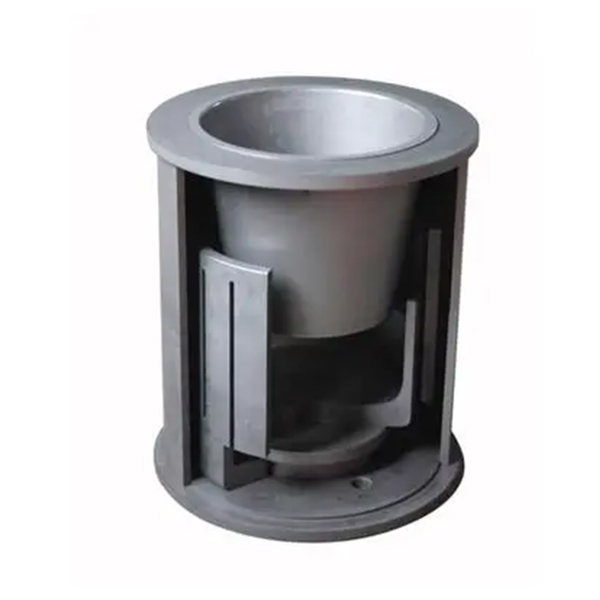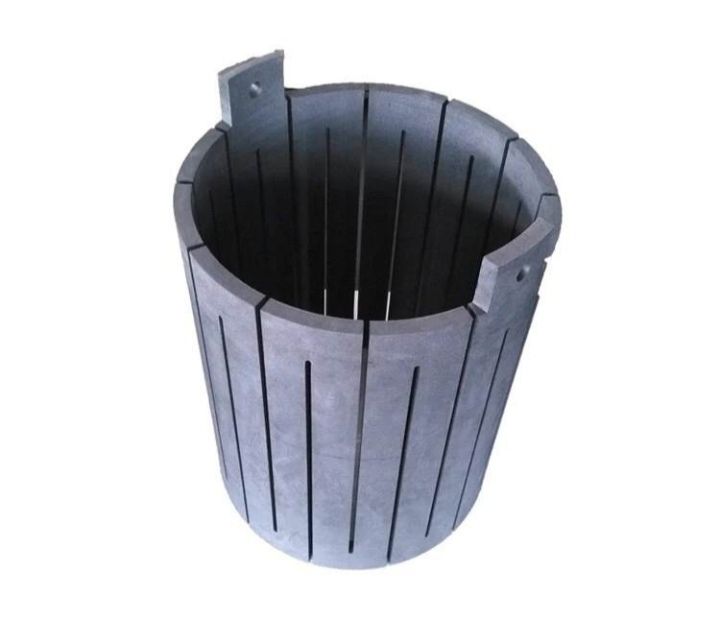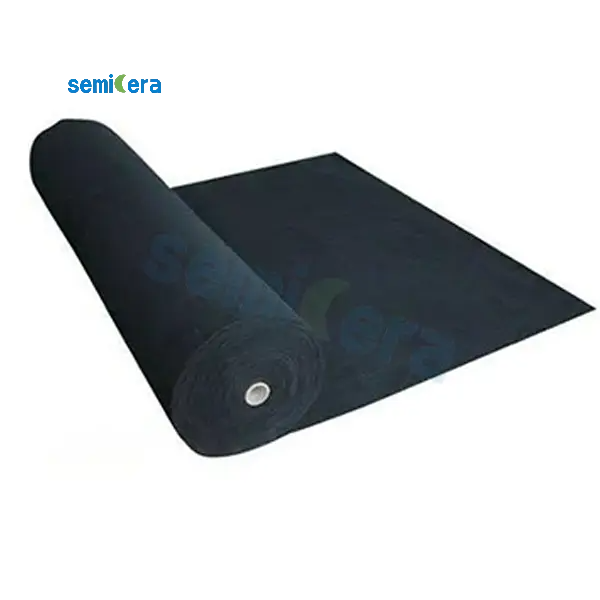The growth process of single crystal silicon is completely carried out in the thermal field. A good thermal field is conducive to improving crystal quality and has high crystallization efficiency. The design of the thermal field largely determines the changes and changes in temperature gradients in the dynamic thermal field. The flow of gas in the furnace chamber and the difference in materials used in the thermal field directly determine the service life of the thermal field. An unreasonably designed thermal field not only makes it difficult to grow crystals that meet quality requirements, but also cannot grow complete single crystals under certain process requirements. This is why the Czochralski monocrystalline silicon industry regards thermal field design as the core technology and invests huge manpower and material resources in thermal field research and development.
The thermal system is composed of various thermal field materials. We will only briefly introduce the materials used in the thermal field. As for the temperature distribution in the thermal field and its impact on crystal pulling, we will not analyze it here. The thermal field material refers to the crystal growth vacuum furnace. Structural and thermally insulated portions of the chamber, which are essential to create the proper temperature cloth around the semiconductor melt and crystals.
one. thermal field structural materials
The basic supporting material for growing single crystal silicon by Czochralski method is high-purity graphite. Graphite materials play a very important role in modern industry. In the preparation of single crystal silicon by Czochralski method, they can be used as thermal field structural components such as heaters, guide tubes, crucibles, insulation tubes, and crucible trays.
Graphite material was chosen due to its ease of preparation in large volumes, processability and high temperature resistance properties. Carbon in the form of diamond or graphite has a higher melting point than any element or compound. Graphite material is quite strong, especially at high temperatures, and its electrical and thermal conductivity is also quite good. Its electrical conductivity makes it suitable as a heater material, and it has a satisfactory thermal conductivity that can evenly distribute the heat generated by the heater to the crucible and other parts of the thermal field. However, at high temperatures, especially over long distances, the main mode of heat transfer is radiation.
Graphite parts are initially formed by extrusion or isostatic pressing of fine carbonaceous particles mixed with a binder. High-quality graphite parts are usually isostatically pressed. The whole piece is first carbonized and then graphitized at very high temperatures, close to 3000°C. Parts machined from these monoliths are often purified in a chlorine-containing atmosphere at high temperatures to remove metal contamination to comply with semiconductor industry requirements. However, even with proper purification, metal contamination levels are orders of magnitude higher than allowed by silicon single crystal materials. Therefore, care must be taken in thermal field design to prevent contamination of these components from entering the melt or crystal surface.
Graphite material is slightly permeable, which allows remaining metal inside to easily reach the surface. In addition, the silicon monoxide present in the purge gas around the graphite surface can penetrate deep into most materials and react.
Early single crystal silicon furnace heaters were made of refractory metals such as tungsten and molybdenum. As the graphite processing technology matures, the electrical properties of the connections between graphite components become stable, and single crystal silicon furnace heaters have completely replaced tungsten and molybdenum and other material heaters. The most widely used graphite material at present is isostatic graphite. semicera can provide high quality isostatically pressed graphite materials.
In Czochralski single crystal silicon furnaces, C/C composite materials are sometimes used, and are now being used to manufacture bolts, nuts, crucibles, load-bearing plates and other components. Carbon/carbon (c/c) composite materials are carbon fiber reinforced carbon-based composite materials. They have high specific strength, high specific modulus, low thermal expansion coefficient, good electrical conductivity, large fracture toughness, low specific gravity, thermal shock resistance, corrosion resistance, It has a series of excellent properties such as high temperature resistance and is currently widely used in aerospace, racing, biomaterials and other fields as a new type of high temperature resistant structural material. At present, the main bottleneck encountered by domestic C/C composite materials is cost and industrialization issues.
There are many other materials used to create thermal fields. Carbon fiber reinforced graphite has better mechanical properties; however, it is more expensive and imposes other design requirements. Silicon carbide (SiC) is a better material than graphite in many ways, but it is much more expensive and difficult to fabricate large-volume parts. However, SiC is often used as a CVD coating to increase the life of graphite parts exposed to aggressive silicon monoxide gas and also to reduce contamination from graphite. The dense CVD silicon carbide coating effectively prevents contaminants inside the microporous graphite material from reaching the surface.
The other is CVD carbon, which can also form a dense layer on top of graphite parts. Other high-temperature resistant materials, such as molybdenum or ceramic materials that are compatible with the environment, can be used where there is no risk of contamination of the melt. However, oxide ceramics have limited suitability for direct contact with graphite materials at high temperatures, often leaving few alternatives if insulation is required. One is hexagonal boron nitride (sometimes called white graphite due to similar properties), but it has poor mechanical properties. Molybdenum is generally reasonable for high temperature applications because of its moderate cost, low diffusivity in silicon crystals, and low segregation coefficient, about 5 × 108, which allows some molybdenum contamination before destroying the crystal structure.
two. Thermal field insulation materials
The most commonly used insulation material is carbon felt in various forms. Carbon felt is made of thin fibers that act as thermal insulation because they block thermal radiation many times over a short distance. Soft carbon felt is woven into relatively thin sheets of material, which are then cut into the desired shape and tightly bent to a reasonable radius. Cured felt is composed of similar fiber materials, using a carbon-containing binder to connect the dispersed fibers into a more solid and stylish object. Using chemical vapor deposition of carbon instead of binders can improve the mechanical properties of the material.
Typically, the outer surface of insulating cured felt is coated with a continuous graphite coating or foil to reduce erosion and wear as well as particulate contamination. Other types of carbon-based insulation materials also exist, such as carbon foam. In general, graphitized materials are clearly preferred because graphitization greatly reduces the surface area of the fiber. These high surface area materials allow much less outgassing and take less time to draw the furnace to a proper vacuum. The other type is C/C composite material, which has outstanding features such as light weight, high damage tolerance, and high strength. Used in thermal fields to replace graphite parts, which significantly reduces the replacement frequency of graphite parts and improves single crystal quality and production stability.
According to the classification of raw materials, carbon felt can be divided into polyacrylonitrile-based carbon felt, viscose-based carbon felt, and asphalt-based carbon felt.
Polyacrylonitrile-based carbon felt has a large ash content, and the monofilaments become brittle after high-temperature treatment. During operation, dust is easily produced to pollute the furnace environment. At the same time, the fibers easily enter human pores and respiratory tracts, causing harm to human health; viscose-based carbon felt It has good thermal insulation properties, is relatively soft after heat treatment, and is less likely to produce dust. However, the cross-section of the viscose-based strands has an irregular shape and there are many ravines on the fiber surface, which is easy to form in the presence of an oxidizing atmosphere in a Czochralski single crystal silicon furnace. Gases such as CO2 cause the precipitation of oxygen and carbon elements in single crystal silicon materials. The main manufacturers include German SGL and other companies. At present, pitch-based carbon felt is the most widely used in the semiconductor single crystal industry, and its thermal insulation performance is better than that of sticky carbon felt. Gum-based carbon felt is inferior, but asphalt-based carbon felt has higher purity and lower dust emission. Manufacturers include Japan's Kureha Chemical, Osaka Gas, etc.
Since the shape of the carbon felt is not fixed, it is inconvenient to operate. Now many companies have developed a new thermal insulation material based on carbon felt - cured carbon felt. Cured carbon felt is also called hard felt. It is a carbon felt that has a certain shape and self-sustainability after being impregnated with resin, laminated, solidified and carbonized.
The growth quality of single crystal silicon is directly affected by the thermal field environment, and carbon fiber insulation materials play a key role in this environment. Carbon fiber thermal insulation soft felt still occupies a significant advantage in the photovoltaic semiconductor industry due to its cost advantages, excellent thermal insulation effect, flexible design and customizable shape. In addition, carbon fiber rigid insulation felt will have greater room for development in the thermal field material market because of its certain strength and higher operability. We are committed to research and development in the field of thermal insulation materials and continuously optimize product performance to promote the prosperity and development of the photovoltaic semiconductor industry.
Post time: May-15-2024



